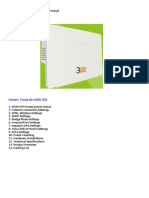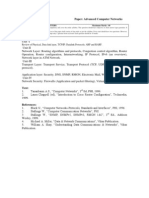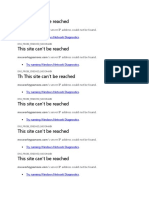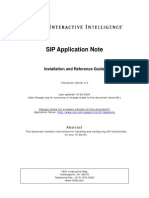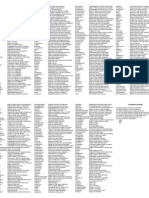7 CN - Question Bank
7 CN - Question Bank
Uploaded by
mmahesh87656Copyright:
Available Formats
7 CN - Question Bank
7 CN - Question Bank
Uploaded by
mmahesh87656Copyright
Available Formats
Share this document
Did you find this document useful?
Is this content inappropriate?
Copyright:
Available Formats
7 CN - Question Bank
7 CN - Question Bank
Uploaded by
mmahesh87656Copyright:
Available Formats
MUTHAYAMMAL ENGINEERING COLLEGE
(An Autonomous Institution)
(Approved by AICTE, New Delhi, Accredited by NAAC & Affiliated to Anna University)
Rasipuram - 637 408, Namakkal Dist., Tamil Nadu.
Department of Computer Science and Engineering
Question Bank - Academic Year (2023-24)
Course Code & Course Name : 21CSF07 & Computer Networks
Name of the Faculty :
Year/Sem/Sec : II / IV /
Unit-I: Introduction
Part-A (2 Marks)
1. Define the term Computer Network.
2. State Data Communication.
3. Define Protocol and Standards.
4. A network with bandwidth of 10 Mbps can pass only an average of 12, 000 frames per minute
where each frame carries an average of 10, 000 bits. What will be the throughput for this
network?
5. Give the components of data communication.
6. Differentiate port address, logical address and physical address?
7. What are the advantages of distributed processing?
8. List out the Transmission modes in Networks.
9. Name the factors that affect the performance of a network.
10. Give an advantage for each type of network topology.
Part-B (16 Marks)
1. Describe the functions of the layers in the OSI reference model. (16)
2. Express the features of the various unguided media. (16)
3. Explain the features of various guided media. (16)
4. Explain the various topologies. (16)
5. Describe the categories of network. (16)
Unit-II : Data Link Layer
Part-A (2 Marks)
1. Write the design issues of datalink layer?
2. What is the main function of datalink layer?
3. Define bit stuffing.
4. What is flow control?
5. How is error controlled in datalink controlled protocol?
6. Discuss the concept of redundancy in error detection.
7. Observe CSMA?
8. Read CSMA/CD. List its types.
9. Examine collision detection?
10. List any four IEEE 802 standards with its name.
Part-B (16 Marks)
1. (a) The message 11001001 is to be transmitted using CRC error detection (16)
algorithm. Assuming the CRC polynomial to be x 3 + 1, determine the message
that should be transmitted. If the second left most bit is corrupted, show that it
is detected by the receiver.
(b) Explain selective repeat and go back –N.
2. Explain the datalink layer protocol HDLC. (16)
3. Complete the CSMA/CD algorithms of Ethernet. (16)
4. Prepare the access method and frame format used in Ethernet and token ring. (16)
5. (i) A block of 32 bits has to be transmitted. Discuss how the thirty two bit block is (16)
transmitted to the receiver using Longitudinal Redundancy Check.
(ii) Consider a 32 bit block of data 11100111 11011101 00111001 10101001 that has to
be transmitted. IF Longitudinal Redundancy Check is used what is the transmitted bit
stream.
(iii)In the Hamming code for a data unit of m bits how do you compute the number of
redundant bits ‘r’ needed.
(iv)What kinds of errors can vertical Redundancy check determine? What kinds of
errors it cannot determine?
6. List the various error detection methods available to detect the errors and Explain with (16)
example.
Unit-III : Network Layer
Part-A (2 Marks)
1. Discover internetworks?
2. Define packet switching?
3. Enumerate Internet Protocol (IP)?
4. Difference between ARP and RARP.
5. Discuss the class field in IP address.
6. Memorize Multicasting.
7. Define the term broad casting.
8. State hostid and netid?
9. What is the purpose of subnetting?
10. Difference between IPv4 and IPv6.
Part-B (16 Marks)
1. Apply the network layer in the Internet and IP addressing. (16)
2. Distinguish IPV4 with neat diagram. (16)
3.(i) Explain CIDR and subnetting in detail. (8) (8)
3. (ii) Discuss DHCP (8)
4. Write short note about ARP & RARP Protocol (16)
5. Short note about IPV6 in detail (16)
Unit-IV : Routing and Transport Layer
Part-A (2 Marks)
1. List out the Routing protocols.
2. Classify the services provided by transport layer protocol?
3. List some of the Quality of service parameters of transport layer
4. Label the functions of transport layers?
5. Compare RIP and OSPF.
6. Define Congestion.
7. Compare flow control versus congestion control.
8. How transport layer performs Duplication control?
9. Difference between TCP and UDP.
10. Define BGP.
Part-B (16 Marks)
1. Explain the congestion control algorithm used to improve the QoS of the Computer (16)
network.
2. With an example network scenario explain the mechanism of Routing Information (16)
Protocol and Specify the routing table contents.
3. Elaborate on TCP congestion control mechanisms. (16)
4. Explain BGP. (16)
5. Manipulate the three-way handshake protocol to establish the transport level (16)
connection.
Unit-V : Application Layer and Security
Part-A (2 Marks)
1. Define WWW.
2. Discuss the three main divisions of the DNS.
3. Describe why HTTP is designed as a stateless protocol?
4. What are the transmission modes of FTP?
5. Compare the HTTP and FTP
6. What is DNS?
7. Define Cryptography.
8. List out the categories of cryptographic algorithms.
9. Define Firewall.
10. What are the Authentication protocols in Cryptography?
Part-B (16 Marks)
1. Construct DNS with reference to its components and working. (16)
2. (i) Demonstrate the message transfer using simple mail transfer protocol. (8)
2. (ii) Write a short note about application layer security. (8)
3. Write short notes on email services of the application layer. (16)
4. Explain the various cryptographic algorithms in detail. (16)
5. (i) Discuss DNS. (8)
5. (ii) Explain Firewall. (8)
Course Faculty HoD
You might also like
- EchoLife HG8145V ManualDocument16 pagesEchoLife HG8145V ManualglobieNo ratings yet
- CS1302 - Computer NetworksDocument5 pagesCS1302 - Computer Networkslm_zakaria4420No ratings yet
- CS1302 Computer NetworksDocument8 pagesCS1302 Computer Networkspuspa2009No ratings yet
- Kings College of Engineering Department of Computer Science & Engineering Question Bank Subject: Computer Networks Year / Sem: III / VDocument4 pagesKings College of Engineering Department of Computer Science & Engineering Question Bank Subject: Computer Networks Year / Sem: III / Vdilip_india_inNo ratings yet
- Computer Networks Year Question BankDocument5 pagesComputer Networks Year Question Bankakhilek100% (1)
- B.E./B.Tech. Degree Examination, April/May 2011 Sixth Semester - Electrical and Electronics Engineering Cs 2363 - Computer NetworksDocument5 pagesB.E./B.Tech. Degree Examination, April/May 2011 Sixth Semester - Electrical and Electronics Engineering Cs 2363 - Computer NetworksannamyemNo ratings yet
- CN QuestionsDocument4 pagesCN Questionsashish3686No ratings yet
- Question BankDocument12 pagesQuestion BankMahu DNo ratings yet
- Ec2352 Computer Networks Question Bank CNDocument4 pagesEc2352 Computer Networks Question Bank CNMuhamed HajaNo ratings yet
- EC8551 Revision QuestionDocument3 pagesEC8551 Revision QuestionRaja PirianNo ratings yet
- @vtucode - in - CN QUESTION BANK 2021 SCHEMEDocument7 pages@vtucode - in - CN QUESTION BANK 2021 SCHEMEvinaykumarms343No ratings yet
- QB-CN-1Document8 pagesQB-CN-1sandeep rangariNo ratings yet
- 2 BTech CS3402 Computer Network Unit2Document4 pages2 BTech CS3402 Computer Network Unit2juveriyasidd35No ratings yet
- Ns Question BankDocument18 pagesNs Question BankSOBANA RAJESHNo ratings yet
- CS2361 CN Im 2013 PDFDocument2 pagesCS2361 CN Im 2013 PDFsaravana102030No ratings yet
- Answer ALL Questions: PART B (5 X 16 80)Document17 pagesAnswer ALL Questions: PART B (5 X 16 80)Ahmed Eid Abd ElRaoufNo ratings yet
- Computer Network Question BankDocument6 pagesComputer Network Question Banktanveshpadyal3No ratings yet
- CN QBDocument4 pagesCN QBjohnbennysNo ratings yet
- CS6551 Computer NetworkDocument10 pagesCS6551 Computer NetworkRajasekaranArunaNo ratings yet
- Network Routing and SwitchingDocument3 pagesNetwork Routing and SwitchingKawsar AliNo ratings yet
- 21CS62 Tie SimpDocument4 pages21CS62 Tie Simpvtuhub2021No ratings yet
- CN Question BankDocument6 pagesCN Question BankARUN PSNo ratings yet
- CN Question BankDocument3 pagesCN Question Bank22r11a05t5No ratings yet
- Question BankDocument9 pagesQuestion BankK R OFFSET PRINTERSNo ratings yet
- AMIE-Computer Network Old Question SortedDocument10 pagesAMIE-Computer Network Old Question Sortedsandeepharidas100% (3)
- Ec2352 Computer Networks Question BankDocument5 pagesEc2352 Computer Networks Question Bankravi12333No ratings yet
- CS6551 Computer NetworksDocument7 pagesCS6551 Computer NetworksMogili sivaNo ratings yet
- Ec2352 Computer Networks Question BankDocument5 pagesEc2352 Computer Networks Question BankVignesh SelvamNo ratings yet
- Unit - 1 (Introduction of Computer Networks)Document5 pagesUnit - 1 (Introduction of Computer Networks)Abhinavv GandhiNo ratings yet
- CN Question BankDocument5 pagesCN Question BankPavan Kumar0% (1)
- Network Security University Question PapersDocument24 pagesNetwork Security University Question PapersfuncrusherrNo ratings yet
- CS52 Super-Imp-Tie-23Document2 pagesCS52 Super-Imp-Tie-23B. SandeepNo ratings yet
- CN PyqsDocument3 pagesCN PyqsVVLNo ratings yet
- Electronics and Communication Engineering: Question Paper Code: X10366Document4 pagesElectronics and Communication Engineering: Question Paper Code: X10366krithikgokul selvam100% (1)
- 7bite2a External IIDocument1 page7bite2a External IISankareswari KaverimanianNo ratings yet
- Adobe Scan Jul 31, 2023Document2 pagesAdobe Scan Jul 31, 2023shezadahmed309No ratings yet
- QB - Computer NetworksDocument2 pagesQB - Computer Networksvaibhav ghanekarNo ratings yet
- NC7101-High Performance NetworksDocument7 pagesNC7101-High Performance NetworkssanthiNo ratings yet
- 7 Sem SyllabusDocument37 pages7 Sem Syllabusdheerajnarula1991No ratings yet
- Network Programming ImpDocument5 pagesNetwork Programming Impsharath_rakkiNo ratings yet
- Subject - Computer NetworksDocument3 pagesSubject - Computer NetworksInformation TechnologyNo ratings yet
- Computer Networks ModelDocument2 pagesComputer Networks ModelMahendran MaheNo ratings yet
- Questions and AnswersDocument4 pagesQuestions and Answersharshkarnewar45No ratings yet
- 18it502 - DCCN - Question Bank-1Document6 pages18it502 - DCCN - Question Bank-1SHANMUGAM SNo ratings yet
- V.M.K.V Engineering College Vinayaka Missions University Department of Information Technology IV YEAR (BATCH - 2006-2010) Mobile ComputingDocument5 pagesV.M.K.V Engineering College Vinayaka Missions University Department of Information Technology IV YEAR (BATCH - 2006-2010) Mobile ComputingpocketoxyNo ratings yet
- Computer NetworkDocument2 pagesComputer Networkjainneha1187No ratings yet
- Question BankDocument3 pagesQuestion BankTikendrajit SarmahNo ratings yet
- Ec3401 2marksDocument3 pagesEc3401 2marksbhuvanaNo ratings yet
- DC Imp QuestionsDocument3 pagesDC Imp QuestionsdeekshachennamshettyNo ratings yet
- CN - Question Bank - Mse - Sep2023Document2 pagesCN - Question Bank - Mse - Sep2023dhruvdhaduk0022No ratings yet
- Question Bank Unit 1-2Document3 pagesQuestion Bank Unit 1-2Vikas ManchalNo ratings yet
- Important Questions CNDocument3 pagesImportant Questions CNankitgupta0429No ratings yet
- MPCDocument5 pagesMPCStella SarkunamNo ratings yet
- May June 2012 6th Sem R-2007Document4 pagesMay June 2012 6th Sem R-2007mcjaya2024No ratings yet
- Computer NetworkDocument8 pagesComputer Networksubhankar chiniNo ratings yet
- Computer NetworksDocument9 pagesComputer NetworkspriyaaramNo ratings yet
- CCNA Certification All-in-One For DummiesFrom EverandCCNA Certification All-in-One For DummiesRating: 5 out of 5 stars5/5 (1)
- Cisco Certified Network Associate (CCNA) and Cisco Certified Network Professional (CCNP): Mastering Network Automation and Programmability Study GuideFrom EverandCisco Certified Network Associate (CCNA) and Cisco Certified Network Professional (CCNP): Mastering Network Automation and Programmability Study GuideNo ratings yet
- p80rn4182 Ver0 1Document106 pagesp80rn4182 Ver0 1Luis RodriguesNo ratings yet
- Chapter 5Document49 pagesChapter 5Rishaal ChandraNo ratings yet
- 23.4 SCTP: Message Boundaries Each Message Is Independent of Any Other Message. This Is ADocument1 page23.4 SCTP: Message Boundaries Each Message Is Independent of Any Other Message. This Is ATushar SaxenaNo ratings yet
- Oxe Ip PortsDocument39 pagesOxe Ip PortsOlivierNo ratings yet
- This Site Can't Be Reached: Try Running Windows Network DiagnosticsDocument16 pagesThis Site Can't Be Reached: Try Running Windows Network Diagnosticsvsajupillai8808No ratings yet
- DS 2df8336iv Ael PDFDocument4 pagesDS 2df8336iv Ael PDFMohan PreethNo ratings yet
- Telmex Col Ipo8Document26 pagesTelmex Col Ipo8Mariano SanchezNo ratings yet
- Cisco Catalyst 3850 NetFlow ConfigurationDocument7 pagesCisco Catalyst 3850 NetFlow ConfigurationCassandra ShafferNo ratings yet
- Eltek A7600-A1 Datasheet enDocument2 pagesEltek A7600-A1 Datasheet enperazamolinaNo ratings yet
- 94 PfSense 2 0 and Beyond BSDCan 09Document36 pages94 PfSense 2 0 and Beyond BSDCan 09Harry Chan Putra. SP. MTCNA. MTCTCE. MTCRENo ratings yet
- Ims Registration Sequence I CSCFDocument2 pagesIms Registration Sequence I CSCFRajan YadavNo ratings yet
- Comparison of Cisco ISR 4000 Models: RouterDocument7 pagesComparison of Cisco ISR 4000 Models: RouterDanielLopezNo ratings yet
- Imunes User GuideDocument63 pagesImunes User GuidefstazićNo ratings yet
- CcnaDocument20 pagesCcnaTrần HàoNo ratings yet
- LTRCRS-3550-Sdwan QOSDocument81 pagesLTRCRS-3550-Sdwan QOSSEMİHNo ratings yet
- CN-model Qps-June 2023Document6 pagesCN-model Qps-June 2023wooyoung654No ratings yet
- SIP Application NoteDocument160 pagesSIP Application NoteLe Van CanhNo ratings yet
- CCNA Notes PDFDocument69 pagesCCNA Notes PDFbk740633No ratings yet
- NS2 NotesDocument9 pagesNS2 NotesPranava PranuNo ratings yet
- 10CSL77 NETWORK - Lab PDFDocument39 pages10CSL77 NETWORK - Lab PDFNooruddinSahebNo ratings yet
- 4 212 586 V02 Ma Tte-Gw-Knx enDocument12 pages4 212 586 V02 Ma Tte-Gw-Knx enCorui BogdanNo ratings yet
- MSCSC2001C04 - Internet Tech - Sem2 - EndSemExamJuly 2021Document2 pagesMSCSC2001C04 - Internet Tech - Sem2 - EndSemExamJuly 2021ManishNo ratings yet
- Fabric OS Commands v7.0: Quick Reference GuideDocument2 pagesFabric OS Commands v7.0: Quick Reference Guiderolhan17No ratings yet
- NSE1 Application SecurityDocument26 pagesNSE1 Application SecurityJhonnySinatraNo ratings yet
- 156-315 80 PDFDocument92 pages156-315 80 PDFahmedNo ratings yet
- 3HH-04416-EDBA-TCZZA-01-R5 - 3 - 01 CLI Command Guide For FD 24Gbps NTDocument3,286 pages3HH-04416-EDBA-TCZZA-01-R5 - 3 - 01 CLI Command Guide For FD 24Gbps NTStavros SotiriadisNo ratings yet
- Castalia TraceDocument49 pagesCastalia TraceloloNo ratings yet
- Anurag Gautam: Mobile:+91-9536511773 Email IdDocument3 pagesAnurag Gautam: Mobile:+91-9536511773 Email IdAnurag GautamNo ratings yet
- ENTPCTE104EN Beta2 Letter PDFDocument1,040 pagesENTPCTE104EN Beta2 Letter PDFHomero Acosta100% (1)
